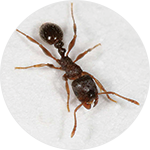Preventing Ants in Food Plants
 Ants are the most common cause of pest related complaints in the United States and one of the first pests on the scene in the spring.
Ants are the most common cause of pest related complaints in the United States and one of the first pests on the scene in the spring.
Ants were ranked number 2 in a recent poll of pest management professionals as the most common cause of pest complaints. They are a diverse group with a variety of preferred habitats. Ants are social insects which may nest in soil, wood or voids. Food plants may experience problems with ants being shipped in on product or inside wooden pallets. They may also come inside from the surrounding exterior as they search for food or new nest sites.
The type of ant pest a site will experience will vary based on geographical location and available resources. There are hundreds of different species of ants in the United States. Thankfully, only a few are pests of structures. Certain ant groups, called tramp ants, are more likely to be transported from one location to another and will easily move their nests when disturbed.
One species, the Argentine ant will be more common in the southeastern and southwestern states. This ant is not native to the United States but has become the most prevalent pest species in the areas they inhabit. A native species, the odorous house ant can be found in most parts of the United States. A more northern species is the pavement ant. It can be recognized by the small dirt craters it creates around paved areas in the soil.
How to Minimize Issues with Ants
Regardless of the species, there are some things that all food plants can do to help minimize issues with these common pests:
-
Inspect all incoming shipments to make sure that ants are not brought into the facility inside shipping containers or wooden pallets. Carpenter ants will create galleries in wooden pallets or may harbor in voids of product containers. A variety of ants can be brought in on cardboard boxes or products where they have been foraging for food. Check the product and the pallet for ants. All ants can contaminate food or food packaging because of their nesting or foraging habits. Nest disturbances can cause a colony to move the entire nest and it could be into a semi-trailer of filled food products. International shipments can result in the introduction of new invasive species which can sometimes create more challenges in getting ant issues under control.
-
Keep food spills to a minimum both outside and inside the facility. Ants are constantly foraging for food. Keep attractants such as food spills to a minimum. Areas like sugar unloading can be particularly attractive to ants especially if the area is not well maintained.
-
Keep expansion joints and floor cracks sealed. Ants like the pavement ant can come up through cracks in floors and expansion joints from underneath the slab.
-
Keep doors and other entry points sealed. Ants tend to utilize natural lines like wires and pipes. They can easily follow these lines inside, for example, the pipe/wall junctures are not properly
-
Avoid the use of wood mulch around the exterior of the structure. Some ants like the odorous house ant will build shallow nests under mulch, rocks and leaf Ants can be brought to the structure with new mulch deliveries.
-
Pick your landscaping plants wisely especially those plants which are close to the building. Many ant species feed on the honey dew or secretions of aphids or other insects which are plant pests. Minimizing plant varieties which support these honey dew producing insects can minimize your ant
-
Report any observed ant activity to your pest management professional. Insecticide baits in conjunction with non-repellent insecticide sprays are the frequently used chemical control methods for ant control. Supplement chemical control with good sanitation and exclusion.
